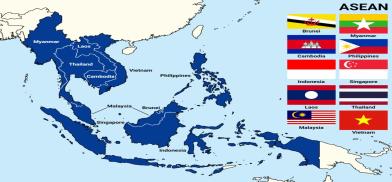ASEAN must reform or become irrelevant; need to get out of China's vice-like grip
The influence of China and its grip on the region remain a predominant factor that has divided ASEAN. One-sided economic dependence on Beijing and the fear of inciting its potential wrath and economic retaliation and potential hard-power measures have stymied the full capacity of the region in managing regional power parity.

ASEAN Day on 8 August 2023 marked the 56th anniversary of ASEAN. While progress throughout the almost six decades of its existence has been mixed, the future ahead is increasingly volatile for the entity, unless it seeks to change its long-held orientation and dogma.
Historically, regional cohesiveness in Southeast Asia is primarily tied to trade and economic activity and common yearning for security assurances. ASEAN was born out of a common fear of communism and external threat, and it remains the same now. However, the capacity to stand up to external threats from a collective joint deterrence and capacity point of view remains lost
Regional awareness and spirit of communal understanding and appreciation remain low, as compared to established systems, especially in similar associations like the European Union (EU)
The lack of any drive to enhance intra-regional connectivity, people-to-people mobility and openness in economic and business investment, and incentivization efforts have hampered true capitalization of joint regional strength and asset derivation. Peer competition and wariness remain stumbling blocks worsened by lingering geopolitical distrusts.
ASEAN has been trapped by its own outdated principles of neutrality in managing relations with external powers. Changing regional and global security architectures have meant that the conventional status quo and dogma of past systems are increasingly becoming irrelevant in ensuring ASEAN remains secure and resilient.
Outdated principles and practices
One of the main objectives of its founding principles and aspirations was the need for regional cohesiveness in order to meet the collective goal of economic prosperity through intra and inter-regional trade and investment and linkages of strategic interdependence.
Others include the aspiration for stronger people-to-people ties, understanding and community confidence and appreciation in creating a deeper regional bond, ease of EU-like mobility and transfer of knowledge and capital. All these remain wanting, and the region and entity are still mired in security dilemmas, mutual distrust and national identity barriers.
With a region as dynamic as Southeast Asia, the different models of governance and historical systems remain a barrier to achieving current and future strategic economic goals. Systemic disparities in development and economic resilience, urban-rural gap, literacy and rights gap, and continental vs archipelago differences, all remain structural hindrances to a regional future-driven socio-economic development.
ASEAN relies on external economic and market lifelines to fuelling its future economic relevance and intra-regional growth and connectivity. This region is primarily shaped by economic and security underpinnings. Despite being labelled the most important region with its vast population of more than 650 million people, its vibrant young demographic advantage, abundance of natural and energy resources that will be able to ensure a lasting and resilient supply chain security and food and energy security, its strategic and vital geographical location in the centre of the global trade and mobility of supply chain, it has somehow not been able to leverage its assets primarily because of its inability to break from past ideological dogmas.
The fact remains that the region will still need to rely predominantly on external powers and sources in ensuring its security and economic growth, and the tools of technology and scientific parameters that are needed to fully utilize and implement the raw advantages and assets it possesses.
Failure to check Beijing's assertiveness
Lacking in both hard and soft power projection, the region and ASEAN remain subservient to the intent and influences of policies by external powers, all while pinning hopes on external powers’ self-restraint and with the perceived returns of its neutrality concept
Consistent realities on the ground that witnessed the various hard power projections and militarization activities in the South China Sea, with continuous grey- zone tactics and intimidation, especially on the Philippines' naval assets recently with the water cannoning of its vessel, all reflect the failed model of ASEAN in managing and preventing tensions and conflicts
The various platforms created ranging from the ASEAN Regional Forum (ARF) to the Treaty of Amity and Cooperation (TAC), ADMM and others have failed to stem regional tensions and and reduce security dilemmas.
Without its own deterrent capacity in ensuring a rules-based order and adherence to international law, incidents of norms and rules-violating activities in disputed territories are predominantly being managed from a weakened position. This is exacerbated by the overdependence on Beijing for the region’s economic needs and internal regime support.
Trapped in its Cold War mindset
ASEAN is seen as a lost cause by the West in trying to project a more effective and credible stance towards Beijing in calling out its aggressive behavior in the region. The renewed US military presence in the Philippines reflects this, and so does the so-called Japan-Philippines-US unofficial alliance or JAPHUS.
The West’s extended deterrence initiative led by Washington and the Pacific Deterrence Initiative are now being relied on by both regional players and the extended players in the Pacific Island chain as the most effective fallback in creating credible and effective shields of deterrence.
ASEAN still remains trapped in its Cold War mindset of hedging its bet on the perceived best returns by maintaining its neutrality. The current security domain has made the old concept obsolete. In a full-blown conflict, neutrality no longer will provide the expected outcome of being safe from any direct or indirect fallout and impact of the conflict. Being non-aligned brings the worst outcome, as neither side will provide the best returns and when a full-blown conflict is triggered, it is too late to start posturing.
The influence of China and its grip on the region remain a predominant factor that has divided ASEAN. One-sided economic dependence on Beijing and the fear of inciting its potential wrath and economic retaliation and potential hard-power measures have stymied the full capacity of the region in managing regional power parity.
The path ahead remains critical for ASEAN to survive and adapt to the stark realities at play, without which ASEAN will face inevitable backfiring on its own principles and aspirations of maintaining a stable and peaceful region.
(The author is a Kuala Lumpur-based strategic and security analyst. Views are personal. He can be contacted at collins@um.edu.my)










Post a Comment